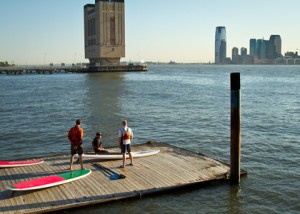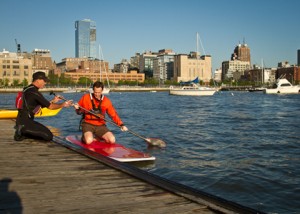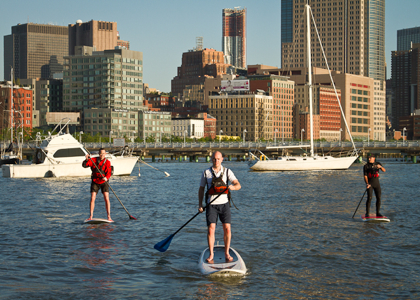What SUP?
When I heard that New York Kayak Co. is offering stand-up paddleboarding classes, my first thought was, What a great story—for someone else to write. But then I remembered that I’m always complaining how I never get to try anything new, and if that meant falling into the Hudson, so be it.
Stand-up paddleboarding (SUP) is like windsurfing without the sail, or maybe kayaking on a surfboard, or maybe surfing without waves. You stand on a big surfboard—more or less—and propel yourself with a paddle shaped like a long flyswatter.
I went to Pier 40 (at Houston) one beautiful weekday evening; New York Kayak Co. has a shop on the south side. After signing two releases—one asked me to recognize “the potential for permanent paralysis and death”—I was loaned a windbreaker and handed a life vest. As we waited, I told photographer Asha Agnish—a SUP devotee who took the photos accompanying this article—how I was mostly concerned about getting onto my feet. Despite growing up in southern California, I’ve never surfed. Moreover, men have a higher center of gravity than women, and because I’m tall, mine is even higher. She scoffed!
The other student, Jason, had never tried SUP either. Our teacher, a former pro surfer named Mark, showed us the boards, and outfitted us with paddles. I was relieved that there was little “classroom” time; we quickly went down to the water.
 I had no trouble maneuvering myself onto the board or staying stable on my knees. But after a couple of minutes, I found the simple act of kneeling to be tough. I can’t remember the last time I knelt for any length of time, and as we bobbed on the water, listening to Mark explain how we were to stand and paddle, I realized that standing was going to be exceedingly difficult. My legs were traumatized and my feet were sore from being extended.
I had no trouble maneuvering myself onto the board or staying stable on my knees. But after a couple of minutes, I found the simple act of kneeling to be tough. I can’t remember the last time I knelt for any length of time, and as we bobbed on the water, listening to Mark explain how we were to stand and paddle, I realized that standing was going to be exceedingly difficult. My legs were traumatized and my feet were sore from being extended.
“If you start to fall, try not to hit the board with the paddle,” said Mark right before I was about to stand for the first time. I assured him that the welfare of the board would the last thing on my mind, unless I happened to fall in slow-motion.
 Standing up wasn’t that hard—I won’t say I was graceful about it—but remaining upright was a challenge. My knees locked and my legs wobbled, which made standing on the bobbing board impossible. I lasted about 15 seconds before going into the water (not that cold!). I got back on, stood for a while, and fell again. And again, and again. I didn’t mind the falling so much—it actually did seem like slow-motion—but my legs were increasingly unwilling to participate. I run for exercise, which is no help when it comes to balancing. I’m not sure I even have the requisite muscles.
Standing up wasn’t that hard—I won’t say I was graceful about it—but remaining upright was a challenge. My knees locked and my legs wobbled, which made standing on the bobbing board impossible. I lasted about 15 seconds before going into the water (not that cold!). I got back on, stood for a while, and fell again. And again, and again. I didn’t mind the falling so much—it actually did seem like slow-motion—but my legs were increasingly unwilling to participate. I run for exercise, which is no help when it comes to balancing. I’m not sure I even have the requisite muscles.
Jason, who never fell, looked like a gondolier. (He’s in the center of the photo at the top of the page.) I looked like Quasimodo moonlighting in Venice. (I’m the one in the red.) We switched boards, and the shorter board was much easier. I improved enough to paddle myself out into the river a bit, and when I saw a ferry wake coming, I managed to turn around without falling.
“You’re getting better!” said Mark.
“It’s because I’m heading back to the dock,” I replied.
But I genuinely did enjoy myself—and you can bet that I’ve told at least 10 people that not only have I tried stand-up paddleboarding, but I’ve also gone swimming in the Hudson. (I bet Jason never has!) I’d attempt SUP again in a heartbeat, although ideally somewhere with calmer water. And I’d be better suited to a situation where I can go off and learn by myself; I find learning borderline shameful, and I don’t like doing it in front of others. Normal people who prefer an attentive instructor will be very happy with New York Kayak Co.
Afterward, I chatted on the pier with New York Kayak Co.’s amiable owner, Randy Henriksen. I trotted out all my excuses, and he politely agreed with them; professional athletes, he informed me, love SUP for the reasons I found it difficult. “Besides,” he said, “you have a very high center of gravity.”
New York Kayak Co. offers two ways to experience SUP. On Wednesdays from 6 p.m. to 8 p.m., for $25, you can give SUP a try without committing to a full class experience. (“Because many people who haven’t done this before fatigue quickly, we take turns with the boards—three of four people per board,” says Randy. “This allows people to visit and rest between tries.”) Reservations are required. Proper two-hour classes are also offered for $100: Beginner ones are Tuesdays at 6 p.m., Saturdays at 9:30 a.m. and 12:30 p.m.; intermediate classes, which are instructor-guided SUP tours out in the river or harbor, are Saturdays at 3:30 p.m. And if you find you love it, you can buy a club membership that provides access to boards or storage for your own board. For more info, see nykayak.com or call 212-924-1327.















Hey Erik,
Great article! Glad you got to experience the joy of SUP first hand. It’s quite a trip isn’t it? Imagine adding waves to the already confusing experience.
Later this summer I will be stand up paddling to New York from Miami via the Atlantic coastline and the Intracoastal waterway. That’s how addicting SUP can be.
Glad you got to experience the stoke of stand up paddling. I’m looking forward to hearing of your second try!
Aloha,
Josh